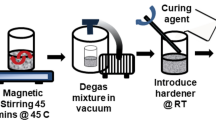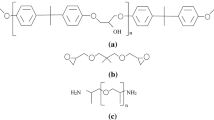Abstract
In this work, a study has been made to examine the application of Ti3AlC2 as a potential reinforcement in novel shape memory polymer (SMP) to enhance its conductivity, mechanical characteristics and shape memory effect. An in-house prepared indigenous two-compound SMP (Epoxy LY556/PCL) was considered along with Ti3AlC2, accounting for 20 wt.% in the smart polymer composites. The two types of SMP were made using Epoxy LY556 with PCL diol and triol, in the proportions of E80:P20 and E70:P30, and with 10 and 12 wt.% triethylene tetra amine (TETA) as cross-linkers. The Ti3AlC2 particle size of 4 µm and 7 µm was reinforced in SMP diol and triol composites. The mechanical and electrical properties were evaluated for neat and reinforced SMP composites. It was observed that the Ti3AlC2 reinforcement have improved the electrical conductivity of the SMP significantly. From the investigation, stiffness and strength values of SMP triol composites were found higher than SMP diol, with composition E80:P20 in 12 wt.% cross-linkers. The shape recovery test was performed subsequently under thermal loading on SMP diol and triol composites, with and without Ti3AlC2 reinforcement. Interestingly, the shape recovery rate of reinforced SMP triol composites was enhanced by 48% (4 µm) and 55% (7 µm), respectively, during the thermal loading, compared to neat SMP triol.

















Similar content being viewed by others
References
Alam J, Khan A, Alam M, Mohan R (2015) Electroactive shape memory property of a Cu- decorated CNT dispersed PLA/ESO nanocomposite. Materials 8:6391–6400
Chen Q, Du P, ** L (2007) Percolative conductor/Polymer composite films with significant dielectric properties. Appl Phys Lett 91:022912
Dang ZM, Lin YH, Nan CW (2003) Novel ferroelectric polymer composites with dielectric constants. Adv Mater 15:1625–1629
Eberhart RC, Shih-Horng Su, Nguyen KT, Zilberman M, Tang L, Nelson KD, Frenkel P (2003) Review: bioresorbable polymeric stents: current status and future promise. J Biomater Sci Polym Ed 14(4):299–312. https://doi.org/10.1163/156856203321478838
Gall K, Dunn M, Finch D et al (2002) Shape memory polymer nanocomposites. Acta Materilia 50:5115–5126
Gunes I, Cao F, Jana S (2008) Evaluation of Nano particulate fillers for development of shape memory polyurethane nanocomposites. Polymer 49:2223–2234
Hu Z, Meng H, Li G, Ibekwe S (2012) A review of stimuli- responsive polymers for smart textile applications. Smart Mater Struct 21:053001
Ivens J, Urbanus M, De Smet C (2011) Shape recovery in a thermoset shape memory polymer and its fabric reinforced composites. eXPRESS Polym Lett 5(3):254–326. https://doi.org/10.3144/expresspolymlett.2011.25
Jaros A, Smola A, Dobrzynski P, Kasperczyk J (2010) Biodegradable shape memory polymers for medical purposes. Science Technique, Chemik 64:87–96
Jerald Maria Antony G, Aruna ST, Raja S (2018) Enhanced mechanical properties of acrylate-based shape memory polymer using grafted hydroxyapatite. J Polym Res 25(5):120. https://doi.org/10.1007/s10965-018-1511-9
**song Leng DDS, Lu H, Liu Y, Du S (2008) Conductive nanoparticles in electro activated shape memory polymer sensor and actuator. In: Proc. SPIE 6931, Nanosensors and Microsensors for Bio-Systems 2008, 693109 (26 March 2008); https://doi.org/10.1117/12.775743
Kai D, Prabhakaran MP, Chan BQ (2016) Elastic poly (epsilon- caprolactone) - polydimethylsiloxane copolymer fiber with shape memory polymer effect for bone tissue engineering. Biomed Mater 11(1):015007
Lendlein A, Kelch S (2002) Shape-memory polymers. Angew Chem Int Ed 41:2034–2057
Li J, Duan Q, Zhang E, Wang J (2018) Applications of shape memory polymers in kinetic buildings. Adv Mater Sci Eng 10(1155):7453698
** P, Wang W, Chen X, **g X (2005) Poly (ε-caprolactone) polyurethane and it shape memory property. Biomacromol 6:587–592
Ratna D, Karger-Kocsis J (2008) Recent advances in shape memory polymers and composites. A review. J Mater Sci 43:254–269
Ren K, Bortolin S, Zhang QM (2016) An investigation of a thermally steerable electro active polymer/ shape memory polymer hybrid actuator. Appl Phys Lett 108:062901
Rousseau IA (2008) Challenges of shape memory polymers: a review of the progress toward overcoming SMP’s limitations. Polym Eng Sci 48(11):2075–2089. https://doi.org/10.1002/PEN.21213
Serrano MC, Ameer GA (2012) Recent insights into the biomedical applications of shape memory polymers. Macromol Biosci 12:1156–1171
Song J, Chang H, Naquib H (2015) Biocompatible shape memory polymer actuators with high force capabilities. Eur Polymer J 14:3057
Vijayakumar MP, Rangaraj L, Raja S (2019) Synthesis and characterization of high-performance Epoxy/Ti3AlC2 reinforced conductive polymer composite. J Compos Mater 53:3861–3874
Wang W, Li CW, Chen KP (2013) Electrical dielectric and mechanical properties of a Novel Ti3AlC2/epoxy resin conductive composites. Mater Lett 110:61–64
Wang J, Chowdhury S, Wu D, Bohnstedt B, Liu Y, Lee C (2017) Carbon nanotube enhanced shape memory polymer nanocomposites for development of biomedical devices. J Nanomed Res 6(1):00141. https://doi.org/10.15406/jnmr.2017.06.00141
**e F, Huang L, Leng J, Liu Y (2016) Thermoset shape memory polymers and their composites. J Intell Mater Syst Struct 27:2433–2455
**n X, Liu L, Liu Y, Leng J (2019) Mechanical model, structures and applications of shape memory polymers and their composites. Acta Mech Solida Sin 32:535–565. https://doi.org/10.1007/s10338-019-00103-9
Xue L, Dai S, Li Z (2010) Biodegradable shape memory block co polymer for fast self-expandable stents. Biomaterials 31:8132–8140
Yang P, Zhu G, Shen X, Yan X, Nie J (2016) Poly(ε-caprolactone)-based shape memory polymers crosslinked by polyhedral oligomeric silsesquioxane. RSC Adv 6(93):90212–90219. https://doi.org/10.1039/C6RA20431G
Yotani K, Nakamoto H, Ikudome S, Yuki A (2014) Muscle contraction and relaxation response to on or off status of visual stimulus. J Physiol Anthropol 33:1–4
Zhang Z-X, Wang W-Y, Yang J-H, Zhang N, Huang T, Wang Y (2016) Excellent electroactive shape memory performance of EVA/PCL/CNT blend composites with selectively localized CNTs. J Phys Chem C 120(40):22793–22802. https://doi.org/10.1021/acs.jpcc.6b06345
Acknowledgements
This work was enabled by the financial support, received from ASTA, CSIR-12th FYP (ESC-0212/02). The authors would like to thank Mr. Mahesh, STTD and Dr. Jaganathan, SID, for extending the facilities for mechanical testing and Mrs. Kalavathi for SEM analysis.
Author information
Authors and Affiliations
Corresponding author
Additional information
Publisher's Note
Springer Nature remains neutral with regard to jurisdictional claims in published maps and institutional affiliations.
Rights and permissions
About this article
Cite this article
Vijayakumar, M.P., Raja, S. & Rangaraj, L. Development of MAX Phase Particles Reinforced Shape Memory Epoxy/PCL Polymer Composites. Trans Indian Natl. Acad. Eng. 7, 897–909 (2022). https://doi.org/10.1007/s41403-022-00336-0
Received:
Accepted:
Published:
Issue Date:
DOI: https://doi.org/10.1007/s41403-022-00336-0




